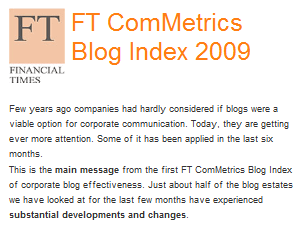 Today is the big day: the Financial Times published our FT ComMetrics Blog Index for 2009 in the newspaper’s regular Digital Business supplement and on its webpage.
Today is the big day: the Financial Times published our FT ComMetrics Blog Index for 2009 in the newspaper’s regular Digital Business supplement and on its webpage.
A decade ago the world’s largest companies were figuring out how to take advantage of the new opportunities offered by the World Wide Web. In the last couple of years, many firms have focused on blogs and most of the noise has been made over the last year. We take a look at some examples and discuss them in some more detail.
In the past, most viewed blogs (or weblogs, to use the technically correct term) as diaries for people to write about and share their lives. However, corporate blogs are a very different kettle of fish and beyond sharing product information, they have the potential to communicate with a wider range of stakeholders, such as prospective employees, investors, suppliers and even consumers or non-profit organizations.
Most corporate blogs have been launched in the last two years, which indicates that companies are still experimenting with how best to use this tool. Consequently, the corporate blogosphere presents a heterogeneous and dynamic field for research. The data indicate some interesting trends.
While most companies ensure that a visitor is aware that he or she has landed on a corporate blog (by including a corporate design and/or landing on the corporate domain), other blogging practices and characteristics vary widely. For instance, eBay blogs under various brand names, such as Skype. Companies can choose from a wide range of blogging software (e.g., Daimler uses open-source WordPress) or can even rely on external blog-hosting sites (e.g., Nestlé’s Purina Chow brand uses TypePad).
Similarly, blogging styles can vary from formal to informal, depending on what the company wishes to portray. Companies can engage almost anyone to blog publicly, from employees to whole departments to CEOs – or they can employ professional freelancers to provide relevant content (e.g., American Express and its Open Forum blog). Finally, blogs are published in a variety of different languages; while some can be translated, this process poses new challenges, such as making sure that the blogger’s personal writing style is not lost in the process.
Clearly, things are still in flux. Still, there are some overriding themes common to most successful bogging ventures, as demonstrated by the FT ComMetrics Blog Index and the FTindex results which illustrates the many different roads that can lead to corporate success in a blogging venture. In no particular order, these are things to keep in mind when blogging:
You can also get a complete report with the results as a free download (just register and voilà):
You can get additional material as PDF files:
- Download press release
Download Financial Times case study
FT ComMetrics Blog Index FTCBI – Kiss the bride
Financial Times May 14 – by Urs E. Gattiker – Corporate blogs: New way to engage with stakeholders
 Find out more about the FT ComMetrics Blog Index and the FTindex results using these links: Leaders by metric, What is top class, Methodology, Good and best practice, Lessons learned, Trends to watch, Your own index report, Free download: PDF report.
Find out more about the FT ComMetrics Blog Index and the FTindex results using these links: Leaders by metric, What is top class, Methodology, Good and best practice, Lessons learned, Trends to watch, Your own index report, Free download: PDF report.
Relevant blog metrics for diary, personal and business blogs
Please subscribe now so you can claim your personal and/or corporate blog AND trace those that you want to compare yourself to.
For Twitter, please use #hashtag ➡ #FTCBI
Pingback: FT ComMetrics Blog Index released: KISS the blog bride
Pingback: World Economic Forum
Pingback: MyComMetrics
Pingback: Urs E. Gattiker